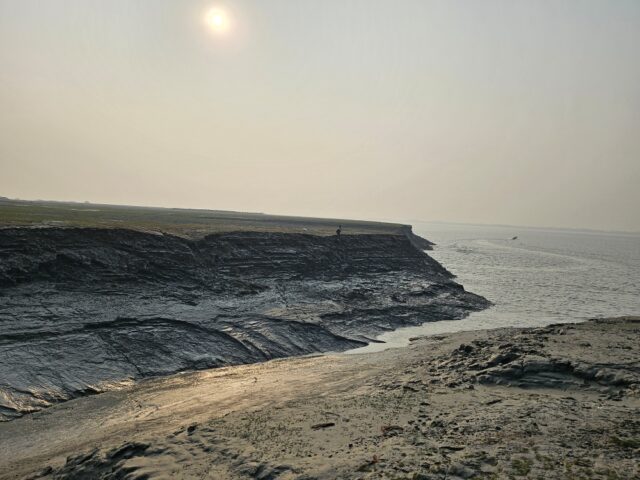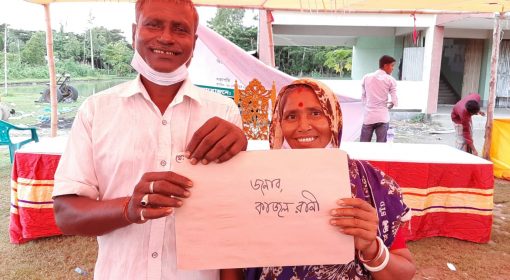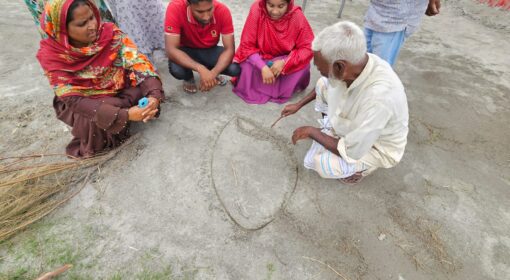By Nargis Begum, Dr. Shibly Sadik (Bangladesh Embassy of the Kingdom of the Netherlands), Jannatul Naim
In the ever-shifting landscapes of the Meghna estuary, resilience is more than a virtue—it’s a necessity. For Nargis Begum, a 42-year-old mother of three, this resilience has been tested time and again. Having lost her homestead twice to river erosion, most recently in March 2024, Nargis’s story is a testament to the strength of the human spirit and the power of bottom-up community-driven support.
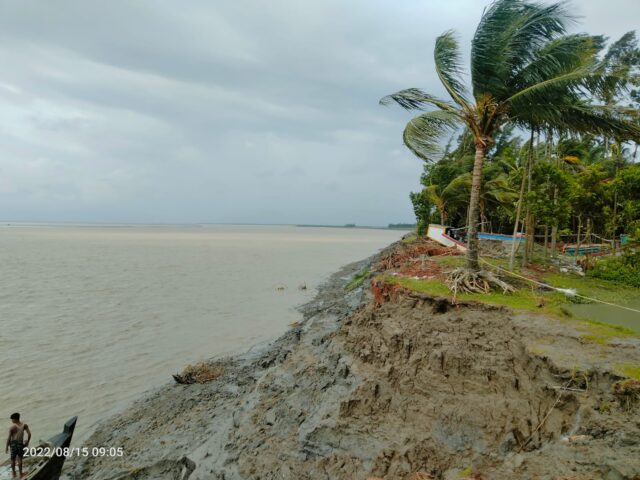
Life amidst a changing landscape
The Meghna estuary, part of Bangladesh’s Ganges- Brahmaputra-Meghna delta, is one of the most dynamic and vulnerable regions in the world. This area gains approximately 25 km² of new land each year due to sediment deposits, but the same forces also take away what they give. For settlers like Nargis, who migrated to the newly formed Noler Char, Hatiya these natural processes are a source of both hope and despair.
The coastal chars are unique, low-lying islands formed from sediment deposits. While fertile, they are prone to flooding, salinity, and cyclones, making life a constant battle against the elements. However, programs like the Char Development and Settlement Project (CDSP), supported by the Netherlands Embassy and IFAD, have introduced new opportunities for settlers to thrive amidst adversity.
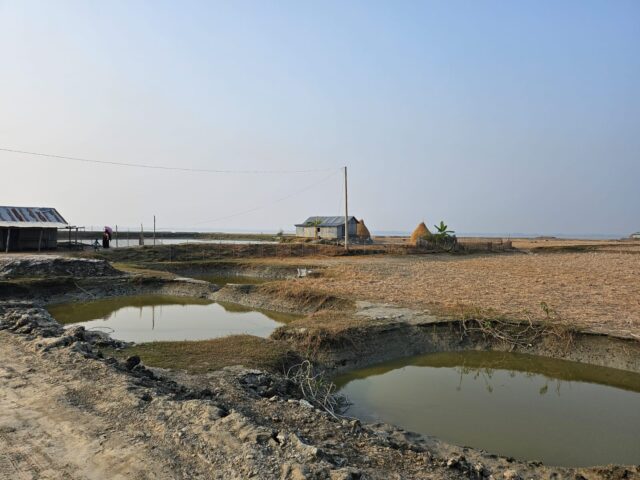
Turning adversity into opportunity
In 2001, Nargis Begum, a river erosion victim, migrated from Hatiya mainland to the newly formed Noler Char in search of stability after losing her home. With her three children and husband, she began a miserable life, scraping together the last of her money to secure a small piece of land from local land grabbers. Clearing bushes and creating a basic yard, they attempted to build a livelihood. During this time, Noler Char became a refuge for other climate-displaced families from nearby regions, all hoping for a fresh start. However, the reality was harsh. Settlers lived in constant fear of exploitation by land grabbers and pirates, often facing physical and mental abuse. The new char was fraught with challenges. Saline water intrusion caused a drinking water crisis, diseases were rampant due to the lack of health services, and poor communication infrastructure left communities isolated. Agriculture was nearly impossible due to the saline soil, and frequent tidal flooding further worsened their plight.
In 2012, hope arrived in the form of the Char Development and Settlement Project (CDSP), initiated by the Government of Bangladesh and the Government of the Kingdom of the Netherlands. Through the project, Nargis and her husband received 1.5 acres of land along with livelihood supports, legally ending their exploitation by land grabbers and giving them a secure foundation to rebuild their lives. CDSP-IV introduced the principles of Local-Led Adaptation, empowering communities through the creation of Field-Level Institutions (FLIs) such as Farmers Forums (FF), Water Management Groups (WMG), Labour Contracting Societies (LCS), Social Forestry Groups (SFG) and Microfinance Groups. These institutions, run by local communities, were key for sustainable development in the region. Nargis joined these groups, receiving training in agriculture, fisheries, and construction work from project support. This training and exiting traditional knowledge transformed her life, enabling her to contribute to her family’s income and participate actively in community development. By addressing the vulnerabilities exacerbated by climate hazards, CDSP not only empowered Nargis to rebuild her life but also strengthened the char community’s ability to withstand future climate impacts. For Nargis, this was not just a second chance but a pathway to thrive in the face of ongoing climate challenges.
After nearly two decades, in March 2024, Nargis once again lost her homestead to river erosion. This time, however, she didn’t break down. Armed with the knowledge and skills she had gained over the years and strengthened by the unwavering support of her community, she faced the loss with resilience and confidence, knowing she could rebuild her life once again.
Reflecting on her journey, Nargis shared:
“Yes, it was heartbreaking to lose my homestead twice in my life. I didn’t leave my house until I saw it collapse into the river before my eyes. But when I looked at my hands, they reminded me of my hard work and the agricultural knowledge I have. I wiped away my tears and started a new journey once again. The project taught me many things, but I had to learn how to live my own life. Most importantly, I learned how to live and thrive within my community”
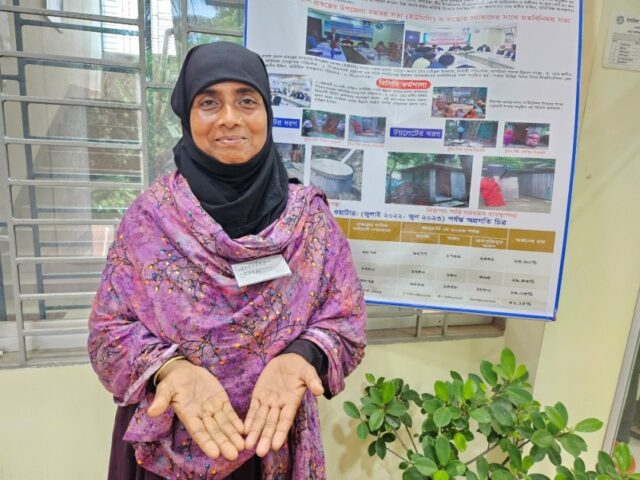
These programs equipped her with more than just practical skills; they gave her the confidence and knowledge to rebuild her life from scratch.
How FLIs empower communities
Field Level Institutions (FLIs) like Farmers Forums, Water Management Groups, and Social Forestry Groups are designed to be participatory and inclusive, with a particular focus on involving women and marginalized groups within the community. During the inception phase of the CDSP project, mass community meetings were held across different landscapes. These meetings allowed community members to voice their challenges and prioritize their needs directly to government departments, project officials, and donors.
These FLIs became a reflection of local community demands, enabling members to execute their own ideas while advocating for sustainable development in their landscapes. Over time, the government began integrating these community-led FLIs as field-level implementation partners, though they remained entirely operated by the local community.
They provided a platform to community for local fund raising, policy advocacy with government and others, ensuring that settlers like Nargis Begum have the skills, resources, and social networks needed to overcome challenges. FLIs also serve as a foundation for long-term development by embedding practices of self-reliance and sustainability within the community.
